Review of Mausoleopsis amabilis (Schaum, 1844) (Scarabaeidae, Cetoniinae), with Description of a New Species and a New Subspecies †
Abstract
:1. Introduction
2. Materials and Methods
- BMNH—Natural History Museum, London, United Kingdom;
- BMPC—Jonathan Ball and Andre Marais Private Collection, Cape Town, South Africa;
- DNSM—Durban Natural Science Museum, Durban, South Africa;
- GBEG—Gerhard Beinhundner Private Collection, Euerbach, Germany;
- ISAM—Iziko South African Museum, Cape Town, South Africa;
- KNEM—National Museums of Kenya, Entomology Department, Nairobi, Kenya;
- MHNG—Muséum d’Histoire Naturelle, Geneva, Switzerland;
- MRAC—Musée Royal de I’Afrique Centrale, Tervuren, Belgium;
- MZUC–Museu Zoológico da Universidade de Coimbra, Portugal;
- PLPC—Philippe Léonard Private Collection, Embourg, Belgium;
- PMPC—Petr Malec Private Collection, Brno, Czech Republic;
- RBINS—Institut Royal des Sciences Naturelles de Belgique, Bruxelles, Belgium
- RPRM—Renzo Perissinotto, Research Material, Gqeberha, South Africa;
- TGMF—Thierry Garnier Private Collection, Montpellier, France;
- TMSA—Ditsong National Museum of Natural History, Pretoria, South Africa.
- Angola—AGO; Benin—BEN; Botswana—BWA; Burkina Faso—BFA; Cameroon—CMR; Central African Republic—CAF; Congo (Kinshasa)—COD; Côte d’Ivoire—CIV; eSwatini—SWZ; Ghana—GHA; Kenya—KEN; Malawi—MWI; Mali—MLI; Mozambique—MOZ; Namibia—NAM; Nigeria—NGA; South Africa—ZAF; South Sudan—SSD; Tanzania—TZA; Uganda—UGA; Zambia—ZMB; Zimbabwe—ZWE. Within South Africa, the key area of this study, provincial codes are used as follows: Eastern Cape Province—EC; Free State Province—FS; Gauteng Province—GP; KwaZulu-Natal Province—ZN; Limpopo Province—LP; Mpumalanga Province—MP; Northern Cape Province—NC; North-West Province—NW; Western Cape Province—WC. Physical distribution codes are: N = North; S = South; E = East; W = West; C = Centre; H = Highlands/veld; L = Lowlands/veld; M = Midlands).
3. Results/Taxonomy
3.1. Mausoleopsis (Mausoleopsis) gariepena sp. nov (Figures 1–4)
3.1.1. Diagnosis
3.1.2. Description of Holotype Male
3.1.3. Derivatio Nominis
3.1.4. Distribution
3.1.5. Type Series
3.1.6. Other Records
3.1.7. Remarks
3.2. Mausoleopsis (Mausoleopsis) amabilis (Schaum, 1844) (Figures 5–11)
3.2.1. Mausoleopsis amabilis interrupta ssp. nov.
3.2.2. Type Series
3.2.3. Other Records
3.2.4. Records of the Other Subspecies of M. amabilis
3.2.5. Remarks
4. Discussion
Mausoleopsis amabilis: Key to Subspecies
- 1 .
- Lateral margin of elytron with two simple, large white maculae, squarish or triangular in shape; mesepimeral and metepisternal white spots absent, or rarely present but then small and fragmented…..………………………………………...................................................2
- –
- Lateral margin of elytron with anterior macula rectangularly elongate and both maculae forming anterior or posterior extensions, respectively, often separated from main macula to form distinct spots; mesepimeral and metepisternal white spots absent or present...............................................................................................................................................3
- 2 .
- Pronotal lateral bands continuous or only partially interrupted along entire margins; aedeagal parameres with depressed elevation of apical projection above central lobe; distribution: WC, NC, EC, FS, GP, NW, LP(H), MOZ(C-W), NAM(S-W), BWA(S-W), SWZ(W), TAN(C), ZWE (E) (Figure 9, Figure 10 and Figure 11)....................M. amabilis amabilis (Schaum, 1844)
- –
- Pronotal lateral bands neatly interrupted at anterior third to form two distinct maculae on each margin; aedeagal parameres with moderate elevation of apical projection above central lobe; distribution: ZN, MP, LP(L), SWZ(E), MOZ(S-C), MWI(S), NAM(N-E), BWA(N-E), ZWE(W), ZMB(S-W), AGO (Figure 9, Figure 10 and Figure 11)........M. amabilis interrupta ssp. nov.
- 3 .
- Lateral pronotal bands and elytral maculae coalesced, or with various degrees of disjunction; mesepimeral and metepisternal spots absent or small and fragmented, respectively; basal pronotal spots of small to moderate size; elytral disc with 1-4 pairs of white spots; aedeagal parameres with elevated apical projection above central lobe; distribution: COD, KEN, MOZ(N), MWI(N), TAN, UGA, ZMB(N) (Figure 9, Figure 10 and Figure 11).............. ......................................................................................M. amabilis heterospila (Gerstaecker, 1867)
- –
- Lateral pronotal bands and elytral maculae completely disjuncted; mesepimeral and metepisternal spots wide and coalesced; basal pronotal spots pair consistently large; elytral disc with 4 pairs of white spots; aedeagal parameres with depressed elevation of apical projection above central lobe; distribution: BEN, BFA, CMR, CIV, GHA, MLI, NGA (Figure 9, Figure 10 and Figure 11)……....................................................................M. amabilis ruteri Antoine, 1989
Author Contributions
Funding
Institutional Review Board Statement
Data Availability Statement
Acknowledgments
Conflicts of Interest
References
- Bouchard, P.; Bousquet, Y.; Davies, A.E.; Alonso-Zarazaga, M.A.; Lawrence, J.F.; Lyal, C.H.C.; Newton, A.F.; Reid, C.A.M.; Schmitt, M.; Ślipiński, S.A.; et al. Family-group names in Coleoptera (Insecta). ZooKeys 2011, 88, 1–972. [Google Scholar] [CrossRef] [PubMed] [Green Version]
- Beinhundner, G. The Cetoniinae of Africa; Gerhard Beinhundner: Euerbach, Germany, 2017; pp. 1–1199. [Google Scholar]
- Antoine, P. Notes sur la systématique des genres voisins d’Oxythyrea Mulsant et Leucocelis Burmeister (Coleoptera, Cetoniidae). Coléoptères 1997, 3, 175–208. [Google Scholar]
- Schaum, H.R. Observationes critiques sur la famille des Lamellicornes mélitophiles. Ann. Société Entomol. Fr. 1844, 2, 333–426. [Google Scholar]
- Gerstaecker, A. Beitrag zur Insekten-fauna von Zanzibar, nach dem während der Expedition des Baron v.d. Decken gesammelten Material zusammengestellt. Arch. Nat. 1867, 33, 1–49. [Google Scholar]
- Antoine, P. Contribution à la connaissance des Cetoniidae du Kenya (Coleoptera, Scarabaeoidea). Coléoptères 2004, 10, 13–28. [Google Scholar]
- Antoine, P. Quelques especes nouvelles ou peu connues de la famille des Cetoniidae (Coleoptera, Scarabaeoidea). Bull. Société Sci. Nat. Compiegne 1989, 64, 3–13. [Google Scholar]
- Marais, E.; Holm, E. Type catalogue and bibliography of the Cetoniinae of the Sub-Saharan Africa. C. Mem. Ser. 1992, 8, 1–117. [Google Scholar]
- Holm, E.; Marais, E. Fruit Chafers of Southern Africa (Scarabaeidae: Cetoniini); Ekogilde: Hartbeespoort, South Africa, 1992; pp. 1–326. [Google Scholar]
- Sakai, K.; Nagai, S. The Cetoniine Beetles of the World; Mushi-Sha’s Iconographic Series of Insects 3; Mushi-Sha: Tokyo, Japan, 1998; pp. 1–421. [Google Scholar]
- Malec, P.; Šípek, P. Additional notes on the biology and ecology of the Cetoniinae fauna of Eastern Cape (EC) and KwaZulu-Natal (KZN) and remarks on captive breeding of these beetles (Coleoptera, Scarabaeidae, Cetoniinae). Cetoniimania NS 2017, 12, 35–75. [Google Scholar]
- Serrano, A.R.M.; Capela, R.A.; Nunes, T.; Van-Dúnem Neto Santos, C. The rose chafers (Coleoptera: Scarabaeidae: Cetoniinae) of Angola: A descriptive checklist with new records and synonymic notes. Zootaxa Monogr. 2020, 4776, 1–130. [Google Scholar] [CrossRef]
- Krikken, J. A new key to the suprageneric taxa in the beetle family Cetoniidae with annotated lists of the known genera. Zool. Verh. 1984, 210, 1–75. [Google Scholar]
- Mucina, L.; Rutherford, M.C. The Vegetation of South Africa, Lesotho and Swaziland. Strelitzia 19; South African National Biodiversity Institute: Pretoria, South Africa, 2006; pp. 1–807. [Google Scholar]
- Perissinotto, R.; Smith, T.J.; Stobbia, P. Description of adult and larva of Ichnestoma pringlei n. sp. (Coleoptera Scarabaeidae Cetoniinae), with notes on its biology and ecology. Trop. Zool. 1999, 12, 219–229. [Google Scholar] [CrossRef] [Green Version]
- Perissinotto, R. Systematics and biology of the Ichnestomina, including new genera and species (Coleoptera: Scarabaeidae, Cetoniinae). Fragm. Entomol. 2020, 52, 217–320. [Google Scholar] [CrossRef]
- Boheman, C.H. Insecta Caffrariae Annis 1838-1845 A J.A. Wahlberg collecta. II. Coleoptera (Scarabaeides); Officina Norstedtiana: Holmiae [Stockholm], Sweden, 1857; pp. 1–395. [Google Scholar]
- Coquerel, C. Note sur lꞌ Oxythirea amabilis, Schaum, et sur la Leucocelis eustalacta. Burm. Ann. Société Entomol. Fr. 1848, 6, 280–282. [Google Scholar]
- Klug, J.C.F. Coleoptera, Käfer. In Naturwissenschaftliche Reise nach Mossambique auf Befehl seiner Majestät des Königs Friedrich Wilhelm IV in den Jahren 1842 bis 1848 ausgeführt. Zoologie V. Insecten und Myriapoden; Peters, W.C.H., Ed.; Georg Reiner: Berlin, Germany, 1862; pp. 1–566. [Google Scholar]
- Dohrn, C.A. Exotisches. Stettin. Entomol. Ztg. Stettin. 1868, 29, 229–243. [Google Scholar]
- Burmeister, H.C.C. Coleoptera Lamellicornia, Xylophila et Pectinicornia. Handbuch der Entomologie 5; Enslin: Berlin, Germany, 1847; pp. 1–584. [Google Scholar]
- Distant, W.L. Coleoptera collected in the Transvaal. Ann. Mag. Nat. Hist. Incl. Zool. Bot. Geol. Lond. 1897, 6, 575–579. [Google Scholar] [CrossRef]
- van Lansberge, J.W. Enumération des Scarabaeides. Rapportes du Pays de Çomalis (Afrique équatoriale) par M. Révoil. Avec diagnoses des espèces nouvelles (1). Bull. Comptes-Rendus Des. Séances Société Entomol. Belg. 1882, 26, 21–31. [Google Scholar]
- van Lansberge, J.W. Coléoptères recueillis par M. G. Révoil chez les Çomalis, Scarabaeidae. In Faune et Flore de Pays Çomalis (Afrique orientale); Revoil, G., Ed.; Challamel Ainé: Paris, France, 1882; pp. 12–44. [Google Scholar]
- Kolbe, H.J. Beiträge zur Kenntniss der melitophilen Lamellicornier. Stettin. Entomol. Ztg. Stettin. 1895, 56, 271–293. [Google Scholar]
- Péringuey, L. Descriptive catalogue of the Coleoptera of South Africa (Lucanidae and Scarabaeidae). Trans. S. Afr. Philos. Society 1907, 13, 1–546. [Google Scholar]
- Heyne, A.; Taschenberg, O. Die Exotischen Käfer in Wort und Bild; G. Reusche: Leipzig, Germany, 1907; pp. 1–262. [Google Scholar]
- Distant, W.L. Insecta Transvaaliensa. A contribution to a knowledge of the entomology of South Africa; W.L. Distant: London, UK, 1911; Volume 1, pp. 253–299. [Google Scholar]
- Bourgoin, A. Scarabaeidae: Trichiini et Cetoniini. In Voyage de Ch. Alluaud et R. Jeannel en Afrique orientale (1911-1912), Résultats scientifiques, Insectes Coléoptères; Librairie des Sciences Naturelles, Léon L’Homme: Paris, France, 1919; Volume 14, pp. 121–192. [Google Scholar]
- Bourgoin, A. Cetoniini. In Voyage de Guy Babault en Afrique Orientale (1912-1913), Résultats scientifiques: Insectes Coléoptères; Babault, G., Ed.; Lahure: Paris, France, 1921; Volume 2, pp. 1–46. [Google Scholar]
- Schenkling, S. Scarabaeidae: Cetoniinae. In Coleopterorum Catalogus; Junk, W., Ed.; W Junk: Berlin, Germany, 1921; Volume 72, pp. 1–431. [Google Scholar]
- Schein, H. Coleoptera (Scarabaeidae): Cetoniinae and Trichiinae. In South African Animal Life; Hanstrom, B., Brinck, P., Rudebeck, G., Eds.; Almquist & Wiksell: Uppsala, Sweden, 1961; Volume 7, pp. 83–112. [Google Scholar]
- Ruter, G. Contribution à l’étude des Cétonides africains. Bull. De L’institut Fondam. D’afrique Noire Dakar 1969, 31, 899–919. [Google Scholar]
- Krajcik, M. Cetoniidae of the World. Catalogue Part I; Typos Studio: Most, Czech Republic, 1998; p. 132. [Google Scholar]
- Kraatz, G. Die africanischen Leucoceliden und die ihnen zunächst verwandten Gattungen der Cetoniden. Dtsch. Entomol. Z. Berl. 1882, 26, 65–78. [Google Scholar] [CrossRef]
- Roets, F.; Allison, J.D.; Basson, R.J. Recent records of fruit chafers (Scarabaeidae: Cetoniinae: Cetoniini) in the southwestern Cape region of South Africa suggest that range expansions were facilitated by human-mediated jump-dispersal and pre-adaptation to transformed landscapes. Afr. Entomol. 2019, 27, 135–145. [Google Scholar] [CrossRef]
- Donaldson, J.M.I. Description of, and a key to larvae of some South African Cetoniinae (Coleoptera, Scarabaeidae). Entomol. Mon. Mag. 1987, 123, 1–13. [Google Scholar]
- Parmesan, C.; Ryrholm, N.; Stefanescu, C.; Hill, J.K.; Thomas, C.D.; Descimon, H.; Huntly, B.; Kaila, L.; Kullberg, J.; Tammaru, T.; et al. Poleward shifts in geographical ranges of butterfly species associated with regional warming. Nature 1999, 399, 579–583. [Google Scholar] [CrossRef]
- Perissinotto, R.; Pringle, E.L.; Giliomee, J.H. Southward expansion in beetle and butterfly ranges in South Africa. Afr. Entomol. 2011, 19, 61–69. [Google Scholar] [CrossRef]
- Geertsema, H. Range expansion, distribution records and abundance of some Western Cape insects. S. Afr. J. Sci. 2000, 96, 396–398. [Google Scholar]
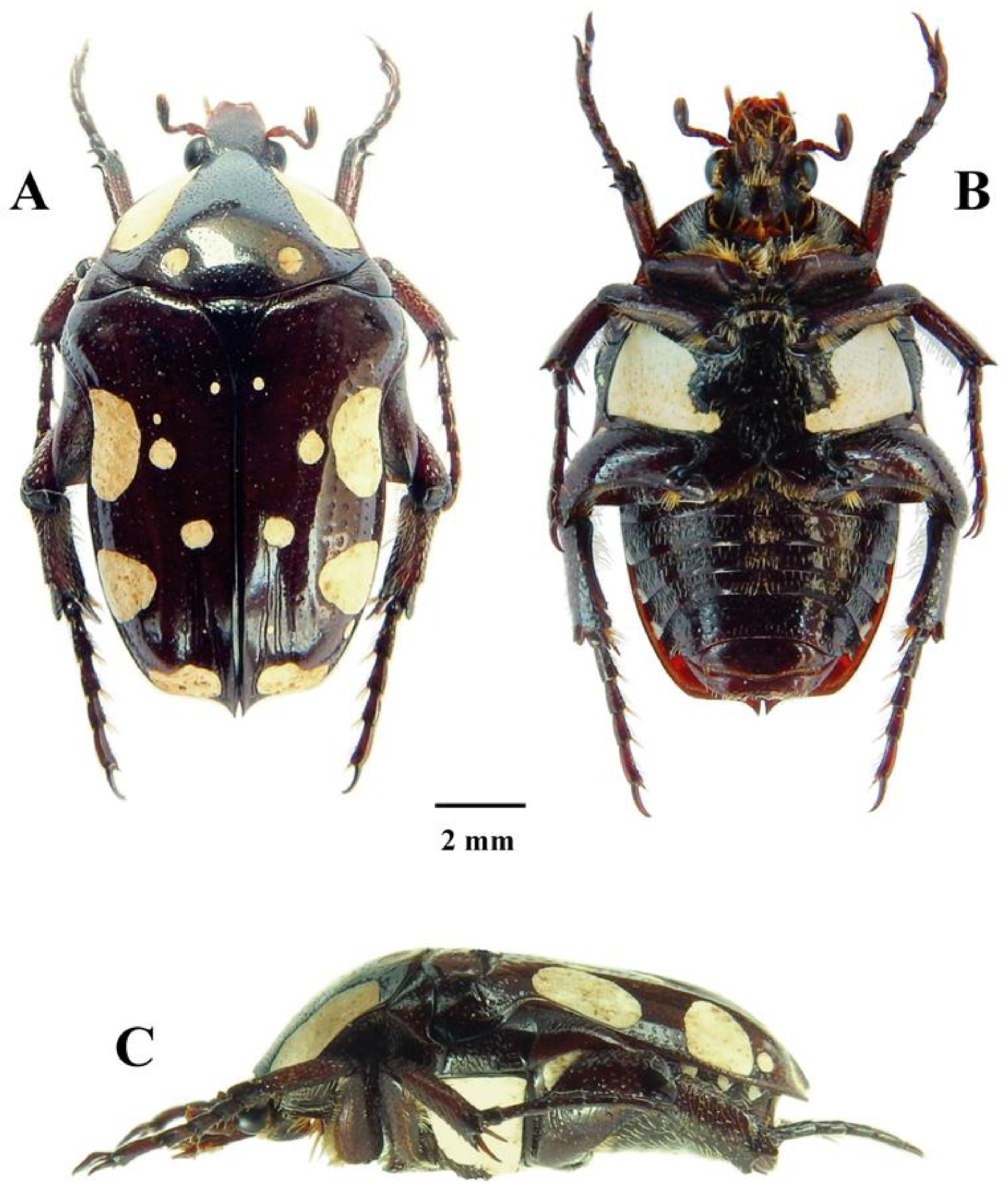
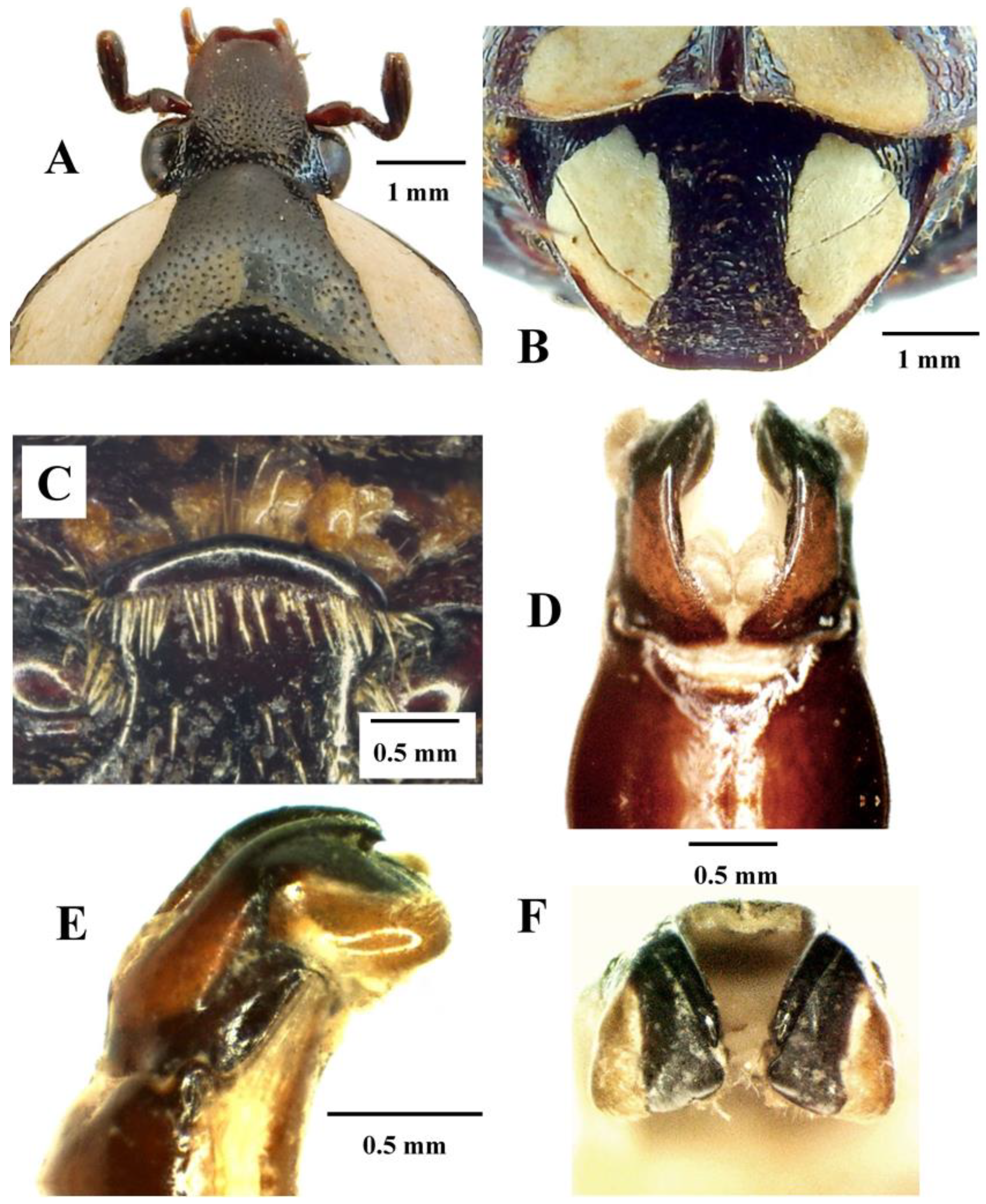

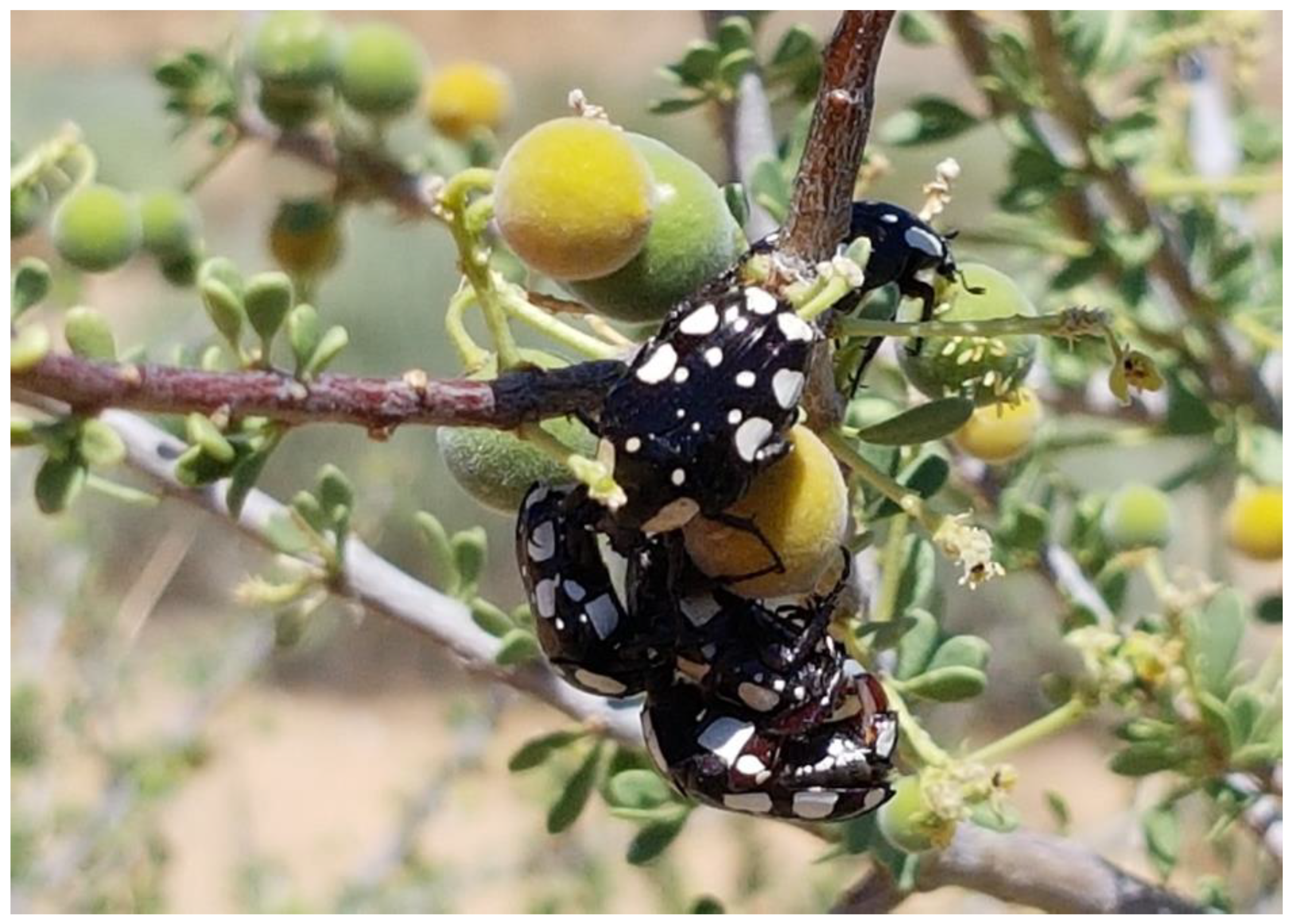

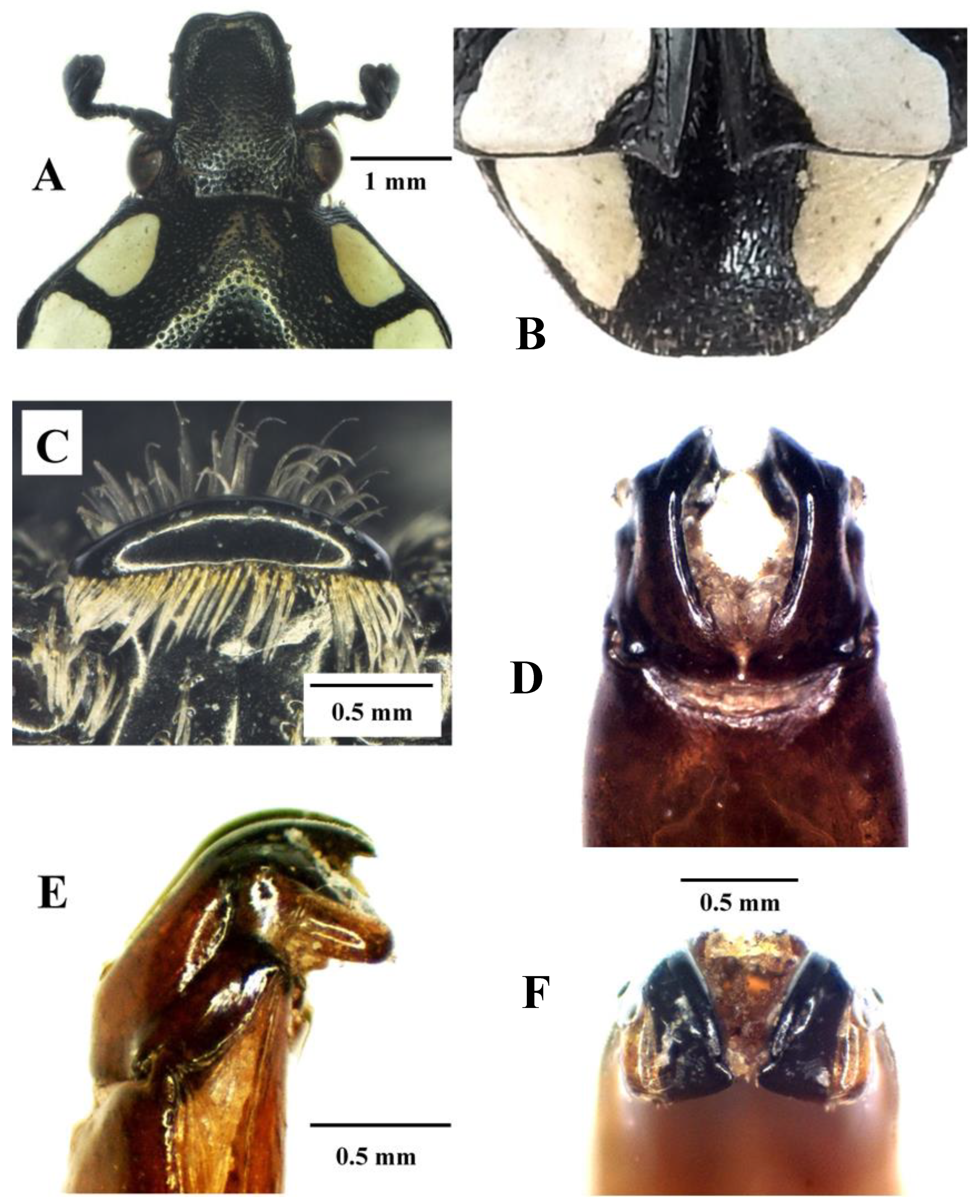


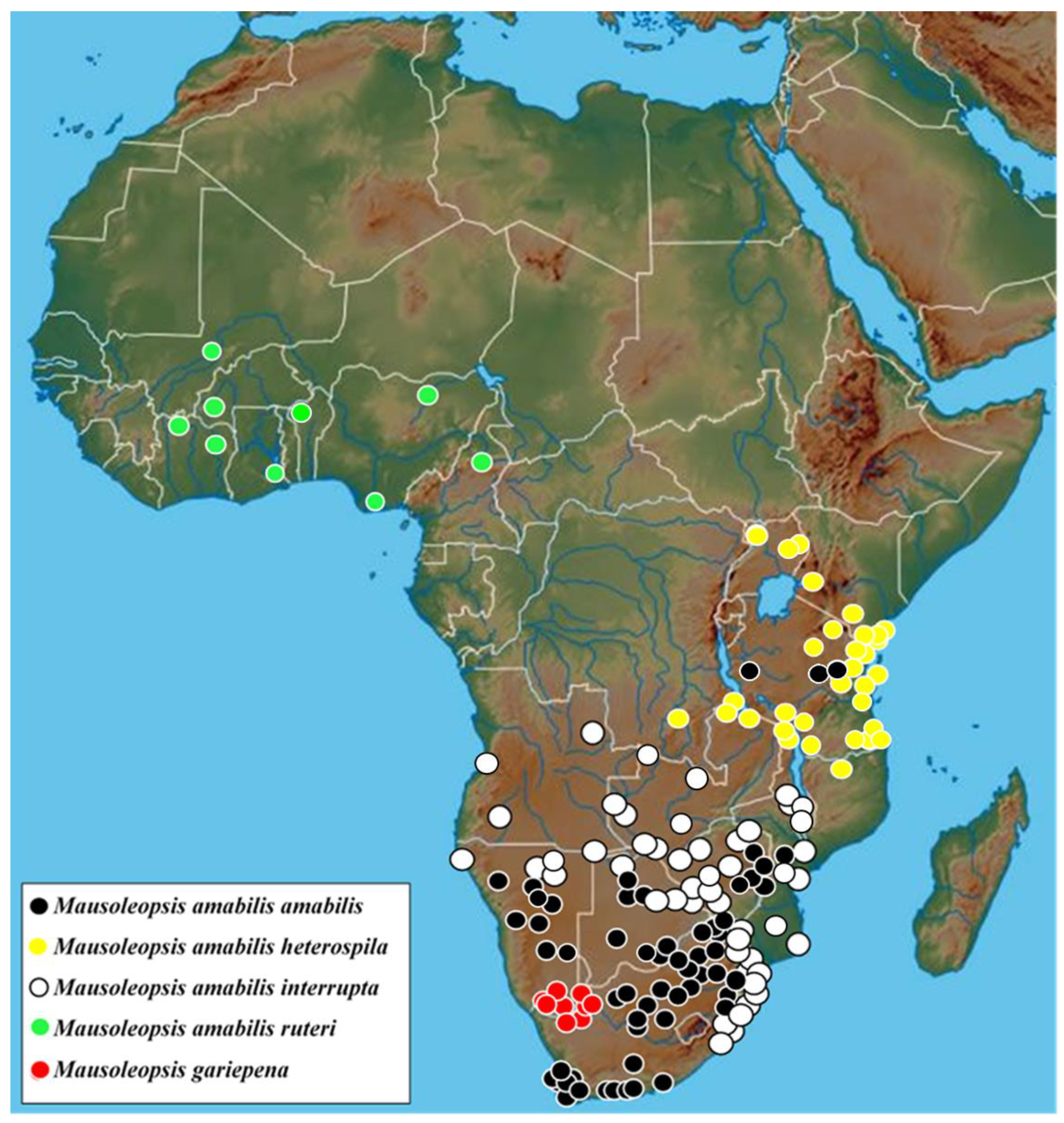
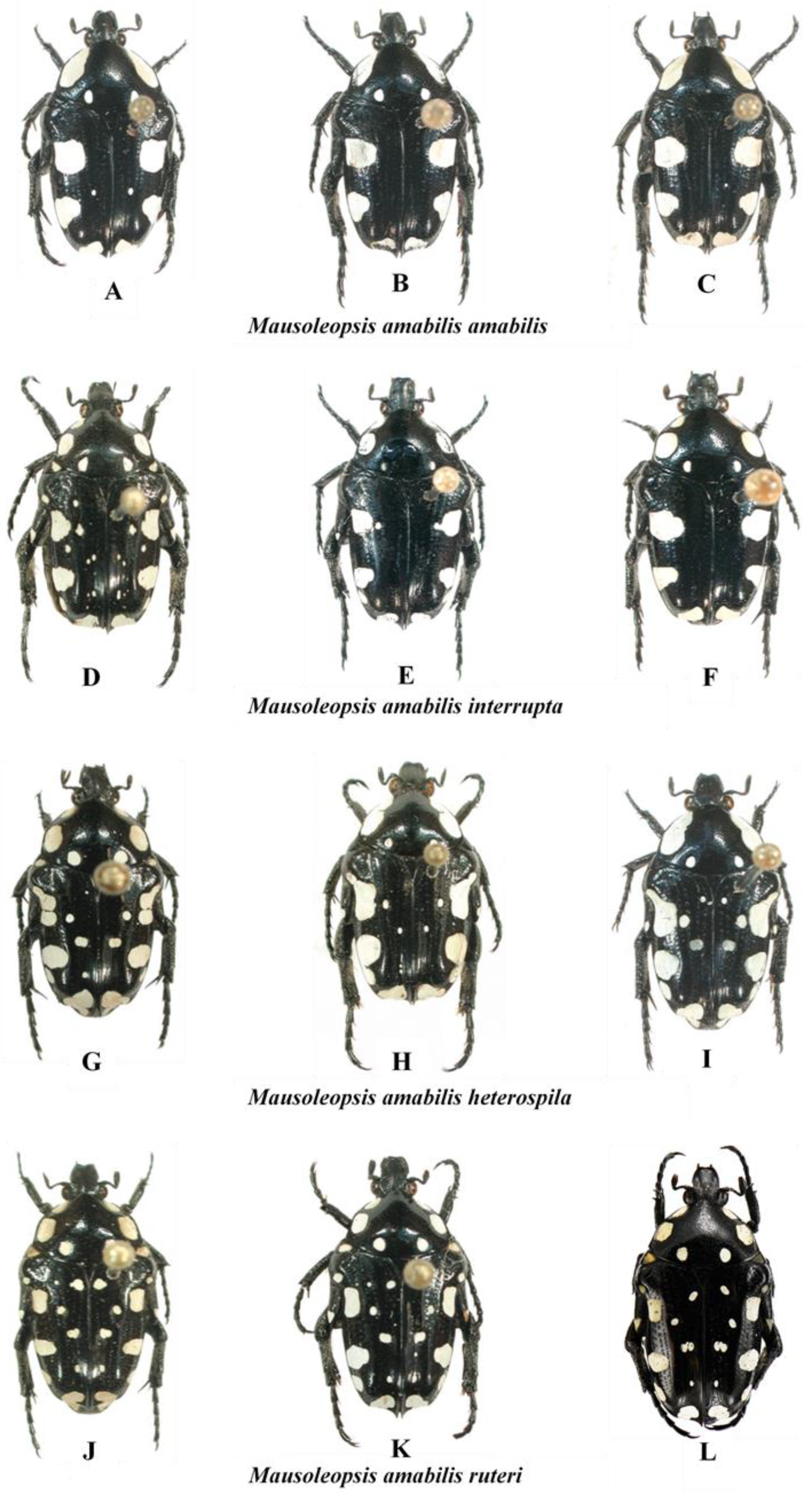

Publisher’s Note: MDPI stays neutral with regard to jurisdictional claims in published maps and institutional affiliations. |
© 2022 by the authors. Licensee MDPI, Basel, Switzerland. This article is an open access article distributed under the terms and conditions of the Creative Commons Attribution (CC BY) license (https://creativecommons.org/licenses/by/4.0/).
Share and Cite
Perissinotto, R.; Beinhundner, G. Review of Mausoleopsis amabilis (Schaum, 1844) (Scarabaeidae, Cetoniinae), with Description of a New Species and a New Subspecies. Diversity 2022, 14, 248. https://doi.org/10.3390/d14040248
Perissinotto R, Beinhundner G. Review of Mausoleopsis amabilis (Schaum, 1844) (Scarabaeidae, Cetoniinae), with Description of a New Species and a New Subspecies. Diversity. 2022; 14(4):248. https://doi.org/10.3390/d14040248
Chicago/Turabian StylePerissinotto, Renzo, and Gerhard Beinhundner. 2022. "Review of Mausoleopsis amabilis (Schaum, 1844) (Scarabaeidae, Cetoniinae), with Description of a New Species and a New Subspecies" Diversity 14, no. 4: 248. https://doi.org/10.3390/d14040248
APA StylePerissinotto, R., & Beinhundner, G. (2022). Review of Mausoleopsis amabilis (Schaum, 1844) (Scarabaeidae, Cetoniinae), with Description of a New Species and a New Subspecies. Diversity, 14(4), 248. https://doi.org/10.3390/d14040248





